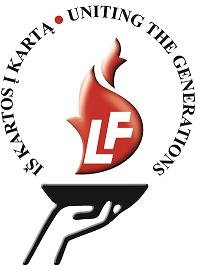New York City, New York
New York (pop 8,5 mln., 14 mln. with suburbs) is undeniably one of the centers of the world.
By the time it received its first 100-floor building in 1931 the tallest "skyscraper" of Lithuania stood at 8 floors. New York must have truly impressed the contemporary immigrants from agricultural Lithuania.
New York was the "entry gate" for the hundreds of thousands Lithuanians who immigrated to America before World War 1, some 15000 settling in NYC for good and others just passing by. Being the world's largest city in the era of 1930-1950 when the Lithuanian Soviet Genocide refugees immigrated, New York attracted a fair share of them as well. Unlike some other once-industrial US cities, New York continued to be important and its Lithuanian community constantly renews itself.
Among the New York Lithuanian sites are numerous memorials and memorial plaques, some of them symbolically created in key locations to mark the importance of Lithuanian-Americans. There were 5 Lithuanian churches, 2 of which survive and are very impressively decorated. Several key Lithuanian organization HQs are located in New York.

Altar of the New York Transfiguration Lithuanian church. Lithuanian symboils such as th eflag, the sun-crosses and more are well visible
New York also played an important role in lives of numerous famous Lithuanians, giving birth to sites related to them. This includes the Transatlantic pilots Darius and Girėnas (who took off from New York for their famous flight), the writer Antanas Škėma (who wrote a semi-autobiographical work about a Lithuanian emigrant in New York that is now considered among the best Lithuanian books ever) and modern artists Jonas Mekas and Jurgis Mačiūnas (who developed their Fluxus art movement in New York).

Jogaila (Jagiello) statue in the New York Central Park
Queens and its modern-ethnic church
Even before World War 1, Lithuanians had their churches in New York. The most unique among the New York‘s Lithuanian churches is Transfiguration church (64-14 Clinton Avenue). Although originally constructed 1908, it was twice rebuilt (once after a fire and, after WW2, due to expanding Lithuanian community). The current building dates to 1962. It is an attempt to create a modern-yet-ethnic Lithuanian style, something impossible in Soviet-occupied Lithuania at the time and only existing in the USA. It is sometimes considered a magnum opus of architect Jonas Mulokas and interior designer V. K. Jonynas who also collaborated on multiple Lithuanian American churches in the 1950s Illinois. For this church, Mulokas received a prize from the American Architects Union, while the "New York Times" (1962 12 02) recognized it among the New York's best architectural works of the year.

New York Transfiguration Lithuanian church
While the building uses modern materials (brick, metal, and glass instead of wood), as well as modern designs (e.g. the statue over the entrance), it has countless Lithuanian symbols in nearly everything. Firstly, the form of the church itself reminds the traditional Lithuanian barn and so does its rooftop. The church belfry is similar to Lithuanian traditional wooden chapel-posts in its form. It is crowned by a Lithuanian sun-cross which also incorporates a moon (a merging of Lithuanian Christian and pre-Christian beliefs). Nearly all the crosses inside the building are also such sun-crosses (including a massive one over the altar). Over the church entrance, Lithuanian words „Mano namai – maldos namai“ greets the visitors („My house – Prayer house“) and the Lithuanian flag is perennially waving together with the US one. A traditional chapel-post stands in the churchyard; it is dedicated to Lithuanians who died for faith and freedom)

Pews adorned in crosses of Vytis at the Transfiguration Lithuanian church

Lithuanian-carved confession rooms at the Transfiguration church. V. K. Jonynas style
Inside the church, Lithuanian ornaments are visible even on the lights, while every pew has a Cross of Vytis on its side. Of course, there are images of Lithuania-related saints and religious traditions, such as St. Casimir. There is also a Lithuanian flag. A memorial plaque to the long-term pastor Frank Bulovas is immediately beyond the entrance. By the way, a street near the church (Perry Av) has an honorary name of Monsignor Frank Bulovas Avenue.
The church is open every day for mass.
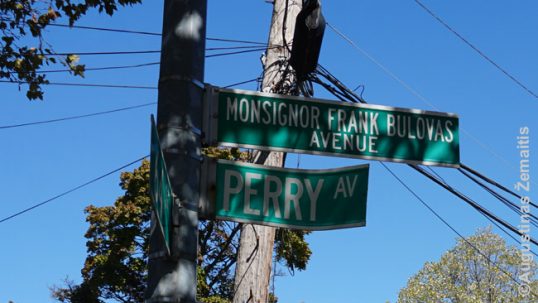
Monsignor Frank Bulovas Avenue sign
The building near the church houses the Lithuanian-American religious charity organization Lithuanian-Catholic religious aid. It distributes money donated by (mostly) Lithuanian-Americans to support Lithuanian religious activities; while Lithuania was occupied by the Soviet Union, LCRA was instrumental in supporting the "Chronicle of Catholic Church", which was not a chronicle per-se but rather an independent clandestine form of media that documented human rights abuses suffered by Lithuanians during the occupation.
Brooklyn‘s Williamsburg, the former Lithuanian district
Williamsburg in Brooklyn was a Lithuanian district in the early 20th century. While most Lithuanian institutions there have since closed down, two church buildings and a Lithuania square remain.
Brooklyn Annunciation Lithuanian Roman Catholic church is the hub of the district. It is a century older than the Queens church (built 1863, 259 N. 5th Street, architect Francis Himpler). It has been constructed by Germans and acquired by a Lithuanian parish in 1914. The interior has been partly redecorated the Lithuanian way: Blessed Jurgis Matulaitis and Gate of Dawn altars created (moved in from the other closed Lithuanian churches, as Annunciation remained the liveliest Lithuanian church in New York). There is also a mural of Our Lady of Vilnius, surrounded by Lithuanian ethnic strip and coats of arms of Lithuania and Vilnius (located at the left side of the altar; created ~1972 in place of a former nun balcony), and St. Casimir praying to its image (right side, 1929). Lithuanians have also added the top part of the altar and the stained-glass windows around the altar (1929 renovation). These meticulous details, together with the older impressive German details (stained-glass windows of 1870, 1860s nave-side frescos by the Munich court painter Esthel, etc.), attract many architecture-loving visitors to the church and it regularly participates in the „Open House New York“ events.

New York Annunciation Lithuanian church exterior

Annunciation Lithuanian church in Williamsburg interior

Our Lady of Vilnius with the coats of arms of Lithuania (left) and Vilnius (right), as she appears at the Annunciation Lithuanian church of New York

The Lithuanian altars of Jurgis Matulaitis (left) and Our Lady of Vilnius (right) at the Annunciation Lithuanian church in Williamsburg, New York
The mass is held in Lithuanian and Spanish (as the neighborhood has a large Hispanic population).
Outside of the church, a Lithuanian sun-cross and a Lithuanian chapel-post were erected. The chapel-post has a Lithuanian inscription „Šv. Marija, saugok Lietuvą ir jos vaikus“ („Holy Mary, save Lithuania and its children“) and a Rūpintojėlis (traditional Lithuanian sad Jesus) figure on top. Such Lithuanian Christian carvings (with some pagan details) are UNESCO immaterial World heritage. A plaque exlplains this artistic tradition in English.
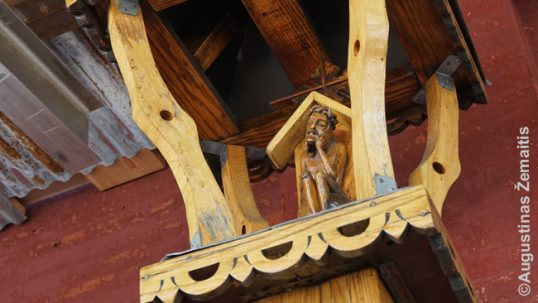
Rūpintojėlis at the chapel-post near the Annunciation church

Lithuanian sun-cross at the Annunciation church
Previously, a convent of Lithuanian nuns was located near the church (until being sold in 1975), however, it has closed, just like the Lithuanian school where the nuns taught at (1972). The square in front of the church is, however, still named after a Lithuanian nun Nicodema.

A small memorial for Nicodema at the Nicodema plaza
The number of parishioners declined from ~4000 families to ~1000 families in 1990 and ~250 families today.
Brooklyn also had a St Mary of the Angels Lithuanian church (corner of 4th S St. and Roebling St.), closed 1981, now El Puente Academy devoid of any Lithuanian marks inside or outside. A simple neoclassical edifice it was famous for the stained glass windows by sculptor V. K. Jonynas it had, most of which were then moved to Our Lady of Vilnius church in Manhattan (see below).

St. Mary of the Angels ex-Lithuanian church
In between of both churches is perhaps the last surviving Lithuanian sign in the area, „Bar Vasikauskas“ (the bar itself is long closed, however).
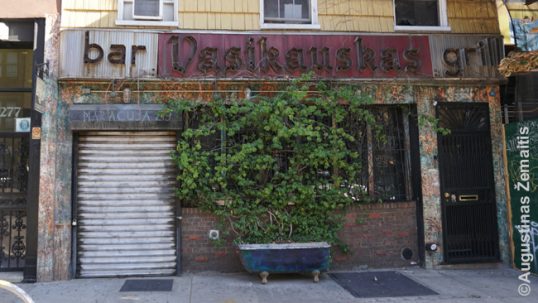
Abandoned bar Vasikauskas sign
Another key Lithuanian feature of Williamsburg, between the 2nd street, Hewes Street, and Union Avenue, is the Lituanica square, also known as Lithuania square, a small patch of land with a monument and flagpole (1957). It is dedicated to pilots Steponas Darius and Stasys Girėnas who became the first Lithuanians to cross the Atlantic by air and the pioneers of Transatlantic air mail. Sadly their 1933 flight which departed from New York Floyd Bennett Field (in Brooklyn southwest of Williamsburg) ended up in a tragedy near their destination in Kaunas, making them martyrs of both Lithuania and Lithuanian-American community. The monument includes a plaque with Darius and Girėnas faces, their Lithuanian quote „Šį savo skridimą skiriame ir aukojame tau, jaunoji Lietuva“ („We dedicate and sacrifice this our flight to thee, young Lithuania“). The monument has been funded by New York Lithuanians. The building next to the plaza that has LACC letters inscribed on its corner also used to belong to Lithuanians (the letters meaning Lithuanian-American Citizens Club).
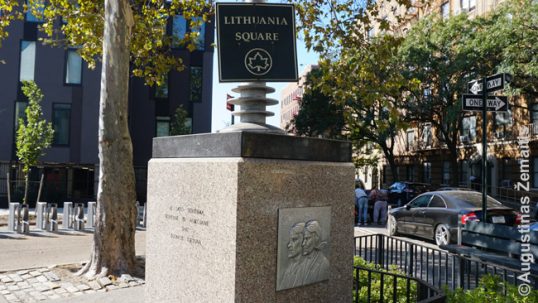
Lithuania Square main monument in Brooklyn

Cornerstone of the Lithuanian-American Citizens Club
Lithuania, independent by then, sought to build a symbolic wing in that airport in 2013 (70th anniversary) but the airport administration denied this. Only a memorial post reminds of Darius and Girėnas there, located in the green line of Flatbush Ave, erected by New York Lithuanian artists Laura Zaveckaitė and Julius Ludavičius in 2013. The airport itself is no longer used (as it became far too small for the New York City). However, currently, it is more like a park where everyone can walk or drive the former runways, see the crumbling hangars and the terminal building, all of which were some of the last ground-level sites seen by Darius and Girėnas.
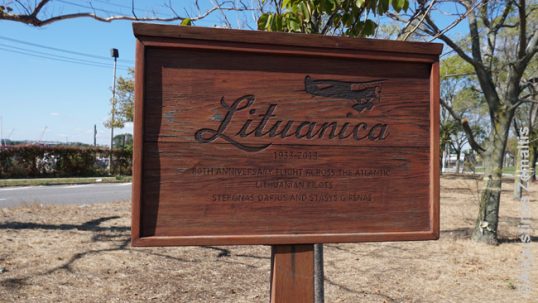
Lituanica memorial post by Ludavičius and Zaveckaitė near the Floyd-Bennet airfield
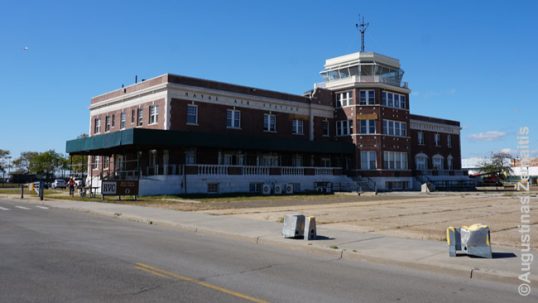
Floyd Bennet airfield terminal

The runway at Floyd-Bennet airport
Another Lithuanian location in Brooklyn outside Williamsburg was the Cultural Heart (Kultūros židinys), a building constructed in 1974 to be a heart of New York Lithuanian activities. It was constructed within the Lithuanian Franciscan monastery. There, the monks together with lay Lithuanians cooperated in furthering both religious and secular Lithuanian goals and countering the Soviet propaganda. However, after 1990 independence, Lithuanian Franciscan leadership was able to relocate back to Lithuania and it decided to raise money by selling the expensive Brooklyn monastery, including the Lithuanian Cultural Heart. This led to an expensive court battle between the monks and the Lithuanians who had donated for the Cultural Heart expecting it to serve the Lithuanian cause for far longer than ~20 years it did. Eventually, an agreement was reached that the monastery and the Heart would be sold, however, a part of the proceeds would go to Lithuanian-American secular activities. In any case, nothing reminds the Lithuanian past of the former Franciscan monastery and the Cultural Heart today. It is a non-Lithuanian monastery now.
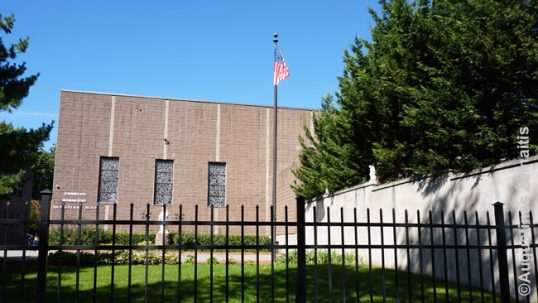
The former Lithuanian Cultural Heart in Brooklyn
The dead Franciscans of the monastery, however, remained in Brooklyn and a had a nice Lithuanian Franciscan monument constructed for them in the Middle Village St. John Cemetery. On one side, all the Lithuanian Franciscan brothers are listed and both Lithuanian and English names of the order presented. On the other side, a short history of how Franciscans went first to Lithuania and then to Lithuanian-Americans. The memorial is covered by a sun-shaped symbol and ethnic patterns.

Lithuanian Franciscan Memorial of New York
The demolished Lithuanian churches of New York
Unfortunately, some of the key Lithuanian locations in New York did not survive.
The most "infamous" Lithuanian church in New York is the gothic revival Our Lady of Vilnius (1910). This only Lithuanian church in Manhattan but it has been closed in 2007. The diocese plans to demolish it and sell the expensive land, triggering the largest Lithuanian-American protests since Lithuania became indpendent. The campaign included mass prayers, vigils, demonstrations attempting to save this "shard of Lithuania", among the last Our Lady of Vilnius churches of Lithuania. Even the Lithuanian president Valdas Adamkus, himself a former Lithuanian-American, protested to the Pope against the church closure. However, all these were unsuccessful and the church was demolished.

Our Lady of Vilnius church squeezed between massive skyscrapers. It no longer exists. Google Street View.
At about the same time, New York's fifth Lithuanian church, the Renaissance Revival St. George's, has been destroyed and replaced by apartment blocks without much attention, likely because of its less glamorous Brooklyn location. Google Street View of 2007 has the only online image of it.
Lithuanian institutional HQs in Manhattan
New York is also the home to a major Lithuanian secular institution. The Lithuanian Alliance of America HQ (307 W. 30th Street) is its small but well-located heart. Now surrounded by skyscrapers, the historic 19th-century four-floored building recently had its exterior renovated to its former glory. It was also listed in National Register of Historic Places, becoming one of very few Lithuanian buildings to become federally recognized heritage. A plaque now commemorates this inscription.

Lithuanian Alliance of America HQ building
The Lithuanian Alliance was the largest pre-war Lithuanian-American organization. It was founded in 1886 by the Lithuanian-American nationalists and leftists who dissented against the central role the Catholic church and its parishes played in many Lithuanian-American activities. Lithuanian Alliance has also served as a life insurance company for Lithuanians. Its membership has declined over the time since World War 2, however, as the new generations of Lithuanians were less likely to join. It went down from 11948 in 1955 to just 2446 in 2007 and merely several hundred today. The Alliance has abandoned its no-longer-lucrative insurance business to become a non-profit. The insurance business, once the major one, was severely hit by the Roosevelt's New Deal which made it mandatory for the employers to insure the employees (immigrants thus no longer needed the ethnic incurances, although these survived many decades afterwards due to people being used to them).
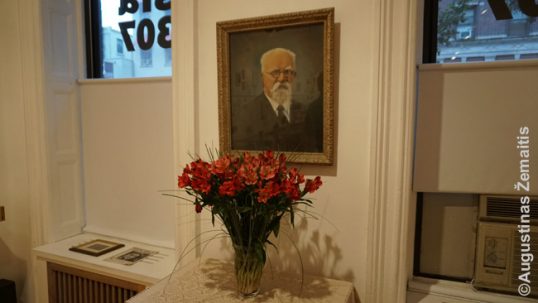
An image of Jonas Šliūpas at the Lithuanian Alliance HQ
In its basement, the Alliance HQ has a massive archive documenting as the former insurance business made it collect more information on its members than usual. Possibly useful for genealogy research, the archive is not fully digitized so far. The second floor has offices with some authentic interwar furniture (you may be allowed to visit if asked during working hours) and "Tautos fondas" Lithuanian charitable foundation, while the top floors have apartments that are rented out making the main profit for the Alliance today. The building also has a small yard which became a hub for New York Lithuanian festivities such as Joninės (midsummer festival) or the July 6th National Day.
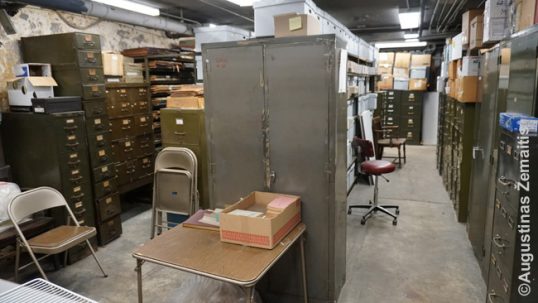
Lithuanian Alliance archives
Lithuanian Alliance publishes the oldest Lithuanian newspaper ("Tėvynė", since 1896), albeit currently the publishing dates are scarce and the printing is done outside the building. Sla 307 gallery is located on the ground floor of the building, celebrating Lithuanian art. It has regular working hours but you need to ring a bell.
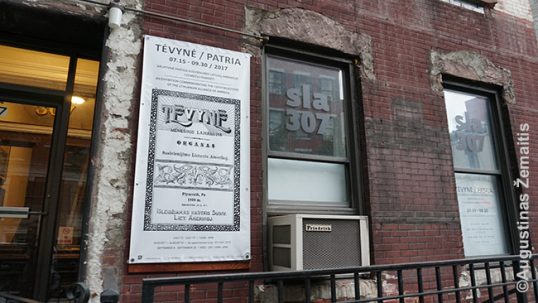
Ground floor of the Lithuanian Alliance in America with SLA307 gallery name
New York is also a political center. It is the location of United Nations HQ and thus the Lithuanian representative office to the UN (the Lithuanian flag, together with all the world's flags, regularly waves near the UN HQ). It also has a consulate-general. Both of those work on rental premises, however, and have no permanent Lithuanian details.

Lithuanian consulate interior
Manhattan Lithuanian memorials
In addition to the Brooklyn memorials for pilots Darius and Girėnas, there are many Lithuanian memorials in the key sites of Manhattan as well.
On a building next to the New York stock market in Broad Street (Manhattan), there was a commemorative plaque for the first famous Lithuanian-American Aleksandras Karolis Kuršius (better known in Latin as Alexander Carolus Cursius-Curtius). This nobleman established the NYC's first Latin school on the location (at the time New York was still a Dutch colony known as New Amsterdam). The plaque for him was created in 1976 for the US 200th anniversary and has been a part of a Lithuanian American struggle to widen the knowledge of the name "Lithuania" and its Soviet occupation. Sadly, the plaque has been removed in 2018.

New York City Stock Exchange where the Cursius plaque was located

Cursius memorial plaque as pictured by the Destination Lithuanian America mission of 2017
Before the massive immigration from Eastern Europe began in the late 19th century such isolated noblemen were the only Lithuanians to set foot on New York shore. One of them - Tadeusz Kosciuszko (Lithuanian: Tadas Kosciuška) - fought for US freedom before unsuccessfully attempting to defend his homeland Poland-Lithuania (united at the time) from European great powers. A commemorative plaque for him has been jointly funded by Lithuanian and Polish Americans in 1997. There are other sites named after him in New York, however, the other sites have no relation to Lithuanians.

Kosciuszko plaque in New York
Another Lithuania-related memorial plaque is on the floor of the New York Library at 476 5th Ave. It cites Martin Radtke, an immigrant from Lithuania, who had a few opportunities for formal education and so educated himself in the library, amassing a fortune he then bequeathed to the library. There is next to none information available about him online, however, save for the plaque. "Radtke" surname was, however, somewhat common among Lithuania's Germans, so it is likely Martin Radtke hailed from that community. It is possible that "Radtke" is a Germanized version of a Lithuanian surname Ratkevičius (Germanization of Lithuanian surnames was common in the German-ruled parts of Lithuania).

The grand interior of New York libarary at the place where Radtke's plaque is

Martin Radtke memorial plaque in the New York library
The first leader of both Poland and Lithuania, ethnic Lithuanian King Jogaila lived at the time America was not even discovered by the Europeans (1348-1434). However, New York Central Park includes a massive Jogaila statue, created by S. Ostrowski. It is one of the most impressive Lithuania-related sites in New York. Symbolically, it is a copy of a sculpture in Warsaw (Poland) that had been destroyed to make WW1 bullets. The Central Park sculpture was made to decorate Polish pavilion in 1939 New York Expo but while that Expo was still ongoing Poland itself was invaded and occupied by Soviet Russians and Nazi Germans. The property of Polish pavilion has then been transferred to the Polish museum but a joint request of New York mayor and Polish consul made it a gift to New York City. As the sculpture has been built by Poles the Polonized version of king's name is used (Jagiello) and the word "Poland" inscribed. However, the description of the king includes Lithuania, and the coat of Jogaila is covered in both Polish and Lithuanian coats of arms.
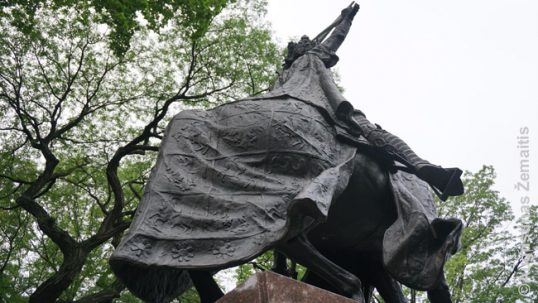
Close-up of Jogaila with Vytis visible
Anatanas Škėma and Lithuanian artists related sites
New York lacks a Lithuanian cemetery, however, the massive private Cypress Hills cemetery includes many Lithuanian graves, such as that of painter Adomas Galdikas. Arguably the most famous among those graves is the Grave of Antanas Škėma, one of the most famous Lithuanian writers. His semi-autobiographical existentialist magnum opus "White Shroud" described the toil and thoughts of an underemployed Lithuanian Soviet-Genocide-refugee in New York, who had to work in an elevator of a prestigious hotel despite being qualified to a white-collar work.

Antanas Škėma grave
Antanas Škėma is claimed to have worked in the elevator himself at the Roosevelt Hotel in central Manhattan. Sadly, the hotel was closed for good during the COVID pandemic.
It is often claimed that Antanas Škėma would be considered among the world's top 20th century writers had he written his work in English, as he effectively debuted existentialism. However, with his work in Lithuanian and accessible only to Lithuanian-Americans (having been effectively banned in the Soviet-held Lithuania), he had very limited readers. He was discovered in Lithuania after 1990 independence (and added to school literature programs there) but is yet-to-be-discovered in America (even many Lithuanian-Americans of today do not know him). Only in 2010s was his "White Shroud" translated into English for the first time.
Other famous Lithuanian-American artists who developed their careers in New York are the FLUXUS artists Jonas Mekas and Jurgis (George) Mačiūnas. Anthology Film Archives is a cinema established by Jonas Mekas which doubles as a repository for independent films.

Anthology film archives, established by a Lithuanian Jonas Mekas
There is also a Commemorative plaque of Jurgis Mačiūnas on the building in SoHo where he had his artist's community in 1967-1969 (16-18 Greene Street). At that time, this was a cheap district for cheap space yet today (thanks to the artist-led gentrification) it is among the more expensive places in Manhattan and any artist community here would now be unlikely.
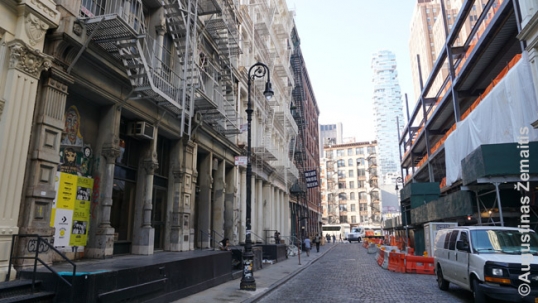
The building where Fluxhouse existed (on the left)

Fluxhouse memorial plaque
Ellis Island and immigrant memory sites
Not just for the Lithuanians, but for most immigrant ethnicities Ellis Island is important as a point through where 12 million immigrants came to the USA in the late 19th and early 20th centuries, among them hundreds of thousands of Lithuanians. The massive halls of the facility now host the US largest museum of immigration.
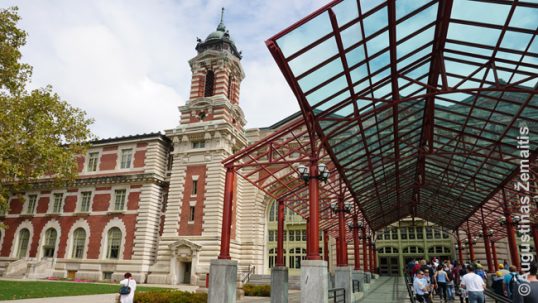
Ellis Island museum of immigration

Main hall of the Ellis Island immigration facility, passed by most Lithuanian-American pre-war migrants
Still, Lithuanians were among the smaller immigrant groups (compared to the Poles, Italians, Germans, Jews...), so, relatively little is available particularly on them in the Ellis Island. But the place is great for learning the experience many Lithuanian migrants had, epitomised in a local quote from an immigrant from Lithuania that basically says that emigration was similar to death in that you wouldn't ever see even your parents anymore.

A quote of a (most likely) Jewess from Lithuania at the Ellis Island museum
A rather new attraction in Ellis Island is the now-abandoned Ellis Island hospital which may be visited on tours. There, those who could be cured would be allowed to immigrate but those who couldn‘t be deported. At the time, health was almost the only one criteria which decided who would be allowed to immigrate to the USA, and the experience of Ellis Island hospital was universal for immigrants of all ethnicities, Lithuanians included. As the deportation of the unhealthy often meant separating families, Ellis Island was also known as the Island of Tears.

Images of immigrants as an art project at the abandoned Ellis Island hospital

Washing room of the Ellis Island hospital
Visiting Ellis Island is possible using the Liberty Island ferries everyday. The visit is easily combinable with the visit to Liberty Island.
In Ellis Island, one may understand the initial moments of how immigrants saw New York skyline and America, and how their first days there went by. On the other hand, in Manhattan's Tenement Museum it is possible to see how those lives continued in America, at least for the minority of the immigrants who stayed in New York City. The museum is established in an authentic 19th-century tenement block. The building has survived unmodified because it had been abandoned before World War 2. It has been reopened now as a museum with authentic public areas and restored apartments. Each of the newly-restored apartments is dedicated to some family that lived in the building and aims to recreate a particular moment of history. One of the restored apartments is dedicated to Rogarshevskys, a Jewish family that had immigrated from Lithuania. Lithuania is mentioned although not accentuated in the exhibit. However, the experience of immigrants of many Eastern European ethnicities at the time was essentially similar, as people were fleeing poverty and persecutions back home and moved to rather uniform tenement blocks of New York. From today's standpoint, life in these tenements may not seem to have been especially affluent either. However, compared to their homelands at the time, the tenement is somewhat elaborate, includes artistic interiors and nice finishing touches. The museum could be visited only with tours; each tour includes two apartments and lasts ~1 hour.

Tenement museum in New York
New York consists of five massive boroughs. Queens has ~6000 Lithuanians, Manhattan ~5000, Brooklyn ~3000, Bronx ~500, Staten Island ~750.
Lithuanian sites in Long Island
Since at least the early 20th century, Long Island has been the abode of the New York's rich. Some of them have hired Lithuanians as servants, giving the beginnings for Long Island's Lithuanian community, centered at Great Neck. The community would swell as people would tell their friends about job opportunities in the mansions. As the time went on, this community was joined by Soviet Genocide refugees (1940s), in many cases relatives of the earlier migrants. There were also Lithuanians who moved in from New York City and post-1990 immigrants.
That said, the Long Island Lithuanian community was never large or cohesive enough to build any buildings (churches or clubs) on its own. Instead, they relied on events in open spaces and multiethnic churches. The new immigrants typically merely replaced the older ones who moved out or assimilated rather than expanding the community.
Lithuanian heritage sites are therefore limited in Long Island but they include Wesey Ct street (actually named after a Lithuanian with a surname Vasiliauskas, who Americanized it to Wesey; the street was layed in his grounds) and the grave of tennis player Vitas Gerulaitis, the most famous Lithuanian who lived in Long Island.

Grave of Vitas Gerulaitis
The map
All the Lithuanian locations, described in this article, are marked on this interactive map, made by the "Destination - America" expedition (click the link):
Upstate New York
Many associates "New York" with the city but unlike the small neighboring states the State of New York is truly expansive (larger than the entire New England save for Maine) and merely a half of its population live in the NYC. The state's remaining part is nicknamed Upstate New York. It consists of smaller cities where the population has halved since the 1960s (total regional population remained the same).
Seven of these cities have old Lithuanian communities with old churches and cemeteries. Unfortunately, the recent years have been sad to them: local dioceses have closed all the Lithuanian parishes that survived a century or more. Not only the Lithuanian mass would be canceled but the buildings themselves were sold to other religions in many cases, destroying or damaging the Lithuanian-inspired interiors. Some exterior Lithuanian details often remain though.
The cemeteries, where they exist, still survive, offering a glimpse to Lithuanian surnames and their anglicizations.


Amsterdam St. Casimir Lithuanian chruch.
Mohawk Valley Lithuanian heritage
Mohawk Valley, a conurbation around the New York state capital Albany, had 3 Lithuanian churches, a chapel and 2 cemeteries.
With some 2,5% of its population of Lithuanian heritage, Amsterdam is the most Lithuanian city in the New York state. It has a large Lithuanian cemetery (Cemetery Rd.), unique for having many of its gravestones inscribed with two surnames: one original Lithuanian and the other one Americanized (i.e. the one immigrants were made to take by the immigration authorities who misheard the surname).


Amsterdam cemetery in New York. This grave has both the Lithuanian (Balčys) and Anglicized (Baltch) surnames marked, and the Lithuanian sun-cross as an ethnic symbol that unites Christian and Pagan beliefs.
At the heart of the cemetery stands St. Anne chapel commissioned by a Lithuanian Kiškis for his beloved wife and built by a famous Lithuanian-American author V. K. Jonynas in 1971. It now serves as a location for the funerary rites with are banned at the graveside in the diocese (previously it also served for the storage of the dead bodies through the winter). The exterior has Lithuanian inscriptions and the Lithuanian sun-cross, a traditional Lithuanian ethnic symbol, as well as bas-reliefs of St. Anne and St. Casimir (with the Lithuanian names of these saints written, Ona and Kazimieras).


St. Anne chapel in the Amsterdam Lithuanian cemetery of New York. The facade incorporates the Lithuanian sun-cross.
The cemetery also has a memorial for local Lithuanians who died in America's wars (6 in WW1, 17 in WW2 and 3 in Vietnam, according to the inscribed surnames).


A memorial for the Lithuanians who died in America‘s wars at the Amsterdam Lithuanain cemetery.
Amsterdam St. Casimir church has been sold to Buddhists after its closure; they established the Five Buddhas Temple there. The community leader Lucas Wang (a.k.a. Holy Master Ziguang Shang Shi) claimed that he received a revelation to purchase the church. United into the World Peace and Health Organization the local Buddhists plan a massive expansion that will even include theme park - but the fate of Lithuanian details of the St. Casimir church is likely sealed. Amsterdam Buddhists typically don't allow outsiders inside, although some sources claim the stained glass windows remain there. The most striking reminder of Lituanity is the St. Casimir statue with Lithuanian inscription on the tower.


St. Casimir statue still remaining on the Amsterdam Lithuanian church facade, with a Lithuanian inscription.
Previously the church area hosted other Lithuanian institutions such as Pakėnas laundry, Piliponis grocery. Today their owners are probably resting in the St. Casimir Lithuanian Cemetery.
The Lithuanian memorabilia from the church (once collected by the priests who visited Lithuania) had been relocated to Walter Elwood museum of Amsterdam history, where many artifacts are presented in a former factory (one in which many Lithuanians surely worked as well).
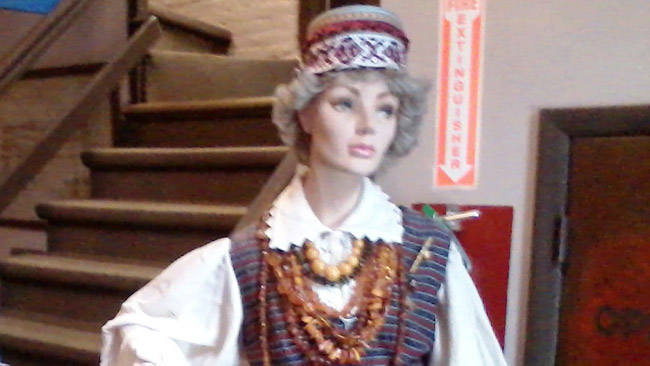

A Lithuanian exhibit in the Walter Elwood museum.
The Lithuanian church building with a dome survives in Schenectady, another Mohawk Valley city (Holy Cross church, 19 N. College Street). It doesn't look like a church as it was built to be a synagogue in 1891; in 1920, however, Jews sold it to Lithuanians as they built a bigger synagogue. Currently, nothing reminds of the buildings many-decades-long Lithuanian history after it was transformed into a stained-glass workshop. A large Lithuanian wooden wayside cross that used to stand outside has been removed or destroyed.


The former Lithuanian church at Schenectady.
Schenectady also has a rather small Holy Cross Lithuanian cemetery (est. 1930). As the parish also had, in later stages, many Italians as its members, the cemetery also has Italian graves. Throughout its history, however, the parish remained mainly Lithuanian and was not rededicated to any other ethnic group.
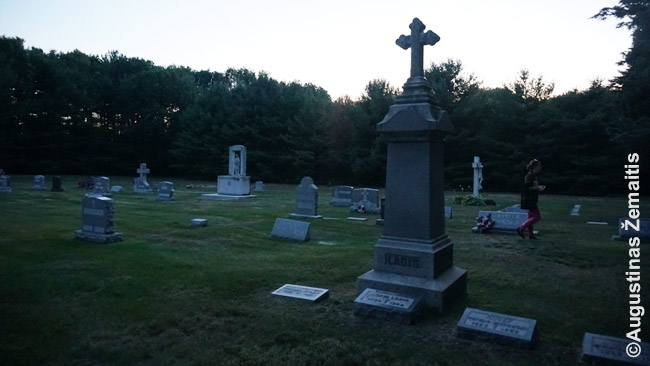

Lithuanian cemetery at Schenectady.
Schenectady is a suburb of the state capital of Albany. Albany itself had a Lithuanian church of St. George once (corner of Thornton and Livingston streets). Built in 1917, it has been closed in 1986. Today the building is used as a community center/soup kitchen dedicated to Sister Maureen Joyce. Blessed Mary statue from the original church, as well as a plaque reminding of Lithuanian history, remains (immediately beyond the entrance) but the interior was destroyed. According to priest Valkavičius who documented Lithuanian churches, the interior used to be shown to architecture students in how to create a grandeur with little available as the church had a pretty tin ceiling. All that was destroyed when transforming into the soup kitchen, however, due to fire prevention requirements (sprinkler installation). Stations of the Cross have been moved to the Lithuanian camp Neringa chapel in Brattleboro. That said, the Albany church was never especially rich in decor, as it was basically just a basement with a wooden belfry: the community never did build a full church which was planned on top of the current church. Therefore, the church never even had stained glass windows.
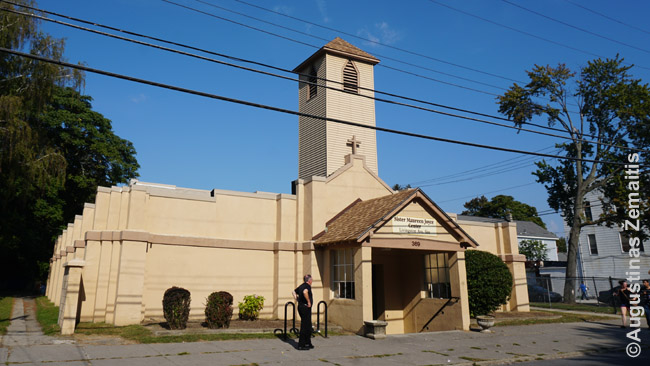

Albany St. George Lithuanian church.
Rochester Lithuanian heritage
Rochester is arguably the liveliest Lithuanian community in Upstate New York and is only second to Mohawk Valley in Lithuanian heritage. Rochester attracted most of its ~400 Lithuanians ~1900 as they have been fleeing hard labor in Pennsylvania mines.
The historic hub of the Rochester Lithuanian community was the St. George Lithuanian church. Like many Lithuanian-American churches, it began as a community praying at other churches, until it has acquired land and built a multi-purpose building.
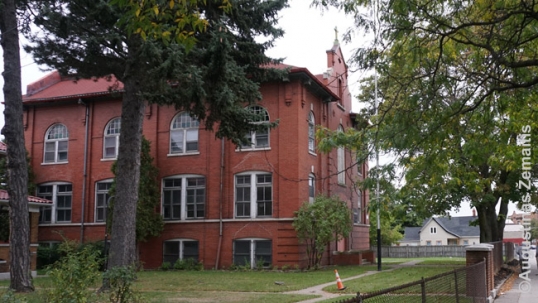

The initial St. George Lithuanian church, later St. George Hall
That building, known as the St. George Hall (erected 1910), is a 3-floored edifice that used to contain church hall, Lithuanian school, an events hall and, since 1976, a Lithuanian Ethnic Museum. The Lithuanian Hall was sold in the 2000s to a Puerto Rican community. Nothing Lithuanian remains at the outside but the event hall still has a Lithuanian coat of arms (as of 2019).
In the late 1920s, Lithuanians planned to expand their church but opted to build a new one nearby, thereby leaving the old building just for the school and events.


Rochester St. George Lithuanian church
The St. George Lithuanian church of Rochester has been built in 1934. It has been sold to Puerto Ricans in the 2000s, together with the Hall and other buildings on the lot. It now serves as a Hispanic independent non-denomination Christian church, however, the stained-glass windows with Lithuanian inscriptions remain inside. Some of the Lithuanian details have been removed by Lithuanians themselves, including the entrance stone and the murals of Our Lady of Šiluva and Our Lady of Vilnius that used to be above the altar. Many of such items, as well as the items from the Lithuanian museum, have been sent to Lithuania according to the local community, although it is unclear where they are now.


Original stained glass window depicting the Vilnius Three Crosses monument
The former Lithuanian lot also has a rectory (without any Lithuanian details) and it had a wooden Franciscan monastery which has been demolished.
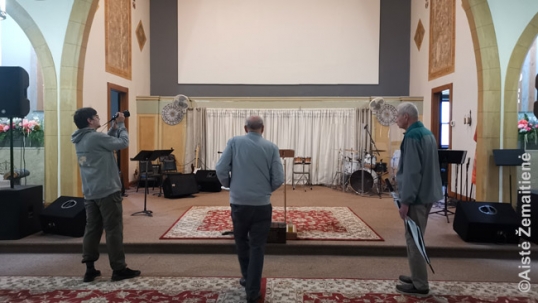

The murals around the altar (over the side-doors) were removed by Lithuanians before the transfer of the building. The walls are thus now empty. The murals used to depict Our Lady of Vilnius (Gate of Dawn) and Our Lady of Šiluva, two major images of Maryan devotion in Lithuania
As the 20th century progressed, the district where the Lithuanian complex was located gradually became ghettoized. The Lithuanians generally moved out in some 1950s-1960s but they continued to come for the Mass and the events. There were proposals to move the church in some 1970s but they did not come through as the priests changed. As the district deteriorated further and the number of Lithuanians declined through intermarriage, it became harder and harder to keep the church going. The financial crisis of 2008-2009 proved to be the final hit, as donations dwindled. Unlike in many other places, however, it was not the diocese that closed the Lithuanian church but rather the parish itself. Officially, the parish remained, however, it now uses another church of Our Lady of Lourdes for its masses.


Lithuanian cross at Our Lady of Lourdes parish, moved from the old St. George church
Such an arrangement allowed to move some of the Lithuanian character from St. George Lithuanian church to the Our Lady of Lourdes Church. In Our Lady of Lourdes, there is a traditional Lithuanian cross at the entrance (moved from St. George and dedicated now to St. George church), as well as some of the articles from St. George Hall Lithuanian museum, as well as a small Lithuanian library and school. There are now „shrines“ to Our Lady of Vilnius as well as a symbolic Lithuanian memorabilia shelf there.
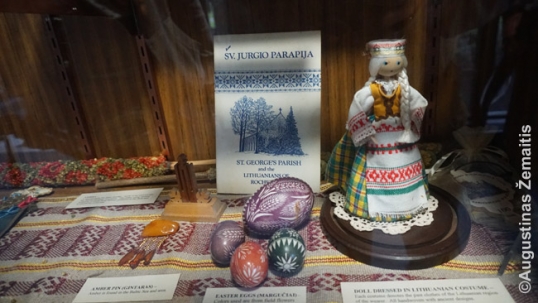

One of the Lithuanian memorabilia shelves at the Our Lady of Lourdes parish
The memorial to Lithuanian war veterans that used to stand in front of the St. George Hall has been relocated to Holy Sepulcher cemetery near the US veteran graves. The memorial was constructed in 1952 by the Gudinas post of the American Legion. While the American Legion is a US veteran organization, this particular Rochester post was named after a Lithuanian war veteran Jonas Gudinas and consisted of ethnic Lithuanian US veterans. Jonas Gudynas was born in Raguva, Lithuania, in 1891, immigrated to Rochester in 1910, joined the American army in 1918 and was killed in France the same year, less than a month before World War 1 ended.


American Legion Gudinas post memorial
Rochester also had a Lithuanian Gediminas club that was associated with the leftists. The building, located on the corner of Joseph and Clifford streets and acquired by the club in 1912, has been demolished as the club was closed down sometime in the 1960s. Near the Gediminas club, the racial riots (Black uprising) of the 1960s took place, one of the events that brought down the district.
In order to perpetuate Lituanity after all the Lithuanian buildings were closed, ~100 Rochester Lithuanians have established a Lithuanian Heritage Society. In 2010 the city established sister ties with Alytus, Lithuania.
Niagara Falls Lithuanian church
Merely 2 km from the world-famous Niagara Falls one may see a century-old Lithuanian coat of arms proudly chiseled on a pediment of a rather grand neo-classical building (1910 Falls Street).
The building used to be St. George's Lithuanian church. Some 100 years ago, the Niagara Falls were used to power industry and many Lithuanians immigrated to staff it. They have built this church as their community hub in 1928. The church reminds of a Greco-Roman temple on the outside. There are Lithuanian details both inside and out. Outside, in addition to the pediment Coat of Arms, there is a small monument dedicated to Rev. Francis J. Aukstakalnis, the Lithuanian priest who served there. Inside, there are 14 stained-glass-windows mostly with Lithuanian inscriptions.


Niagara Falls St. George Lithuanian church
Unfortunately, ~2010 a parish reform in Niagara Falls left 9 Catholic churches open out of the previous 21 (in 1960 the city had a population of 102 394, 2010 census counted merely 50 193). Niagara Falls St. George Lithuanian church has been among those closed. Its congregation peaked in 1971 and then began declining as the entire town became poor and unsafe. Ultimately, the building has been sold to the Independent Anglican Church (Canada Synod). This small Christian community left the St. George dedication untouched and even invited the Lithuanians to continue using the premises. No interior details have been destroyed; on the contrary, the new owners felt sad that Roman Catholics removed some pieces upon closure.


Pediment with Lithuanian coat of arms at the Niagara Falls Lithuanian church
The new owners Independent Anglican church (Canada Synod) have formally elevated the church‘s status to that of the cathedral: the church is actually now the main bishop‘s (Primate's) seat of the entire denomination that consists of more than 10 parishes, some of them as far away as Mozambique.
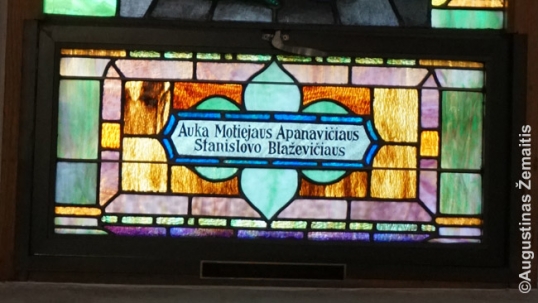

Lithuanian donor names on the stained-glass window of Niagara Falls Lithuanian church
St. George Lithuanian church is, however, located in what is considered a bad district where crime and urban blight is rampant. As such, the church has few faithful attending its Mass while its primary mission now is charity for the inhabitants of the area. Many lots are now empty in the surroundings with their buildings destroyed yet the St. George Lithuanian church continues to have use and purpose.
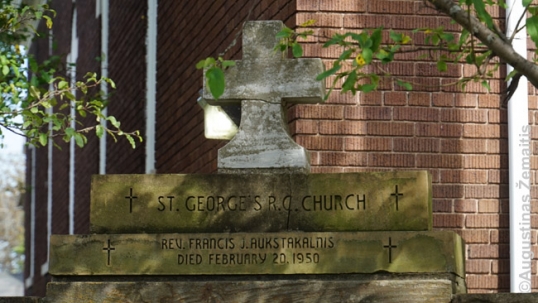

Memorial to the former priest outside of the church
Utica Lithuanian church and cemetery
Utica city of New York state has both Lithuanian church and a Lithuanian cemetery (one of merely three Lithuanian cemeteries in the entire state of New York).
Utica St. George Lithuanian church is a small building dating to 1967 when it replaced an older church. It is one of the smallest Lithuanian churches in America. It has been closed in 2007 and stands empty.


Utica St. George Lithuanian church
St. George Lithuanian cemetery is where the members of the Lithuanian parish used to be buried and one may see many Lithuanian graves there, although nearly no Lithuanian inscriptions or those mentioning Lithuania as the cemetery was established after the Lithuanian-Americans who came before World War 1 (the bulk of Utica community) were somewhat assimilated.


A grave inscribed with 'Born in Lithuania'. Given the later date for establishment of the cemetery such inscritions are rare.
The gate has an English-only inscription and is dedicated to Balutis family. There are many Lithuanian surnames.
The cemetery is located along the same road as many other ethnic and minority cemeteries of Utica.


St. George Lithuanian cemetery in Utica
Binghamton Lithuanian heritage
Lithuanians (~500) also live in Binghamton. This community's history is similar to its many "siblings" in Upstate New York. It began before World War 1 and the highest point of Lituanity was in the 1930s. This golden era is still reminded by a dusty inscription "Lithuanian Natl. Assc. Inc." on a ~1917 building at 315 Clinton Street. While the building has few surviving Lithuanian details, it is otherwise very authentic; so authentic, in fact, that it is one of the very few Lithuanian buildings to be inscribed into the USA's National Register of Historic Places. What served Lithuanians as offices and event hall, now serves the local Tri-City Opera which has acquired the building in 1964 and used it as its base since.
City landmarks list also lists "Sokolvonia" building (~1939) as Lithuanian although a likely Slavic name may indicate a mistake.
Subsequently, the membership of many Lithuanian organizations grew older, the usage of Lithuanian language grew limited to ethnic events. However, many still guarded cherished folk customs and amber jewelry as something that reminded them of their homeland. The arrival of refugees after the occupation of Lithuania (~1950) triggered a limited rebirth of Binghamton Lituanity. However, the DPs left the Upstate New York for work-laden major cities once they could.
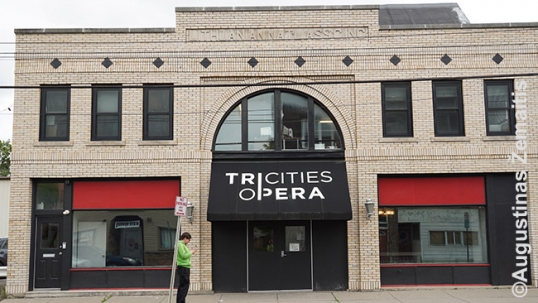

Binghamton Lithuanian Association building


Remaining Lithuanian inscription on the Lithuanian club.
Like elsewhere, the church life survived the longest in Binghamton. The modern facade of St. Joseph Lithuanian church (1 Judson Ave, built in 1949-1950) still has a Lithuanian inscription over its doors. However, the building has been sold to Grace Tabernacle church in 2008. Multiple ethnic parishes have been consolidated into a single Holy Trinity parish in the former St. Ann Church. Some things of St. Joseph have been moved in there: electric organ, carillon, the Last Supper. The sources claim that the Lithuanian church had an especially ethnic interior - priest Valkavičius, who wrote about the Lithuanian-American parishes, even suggested tourists to stop and look at it.


Binghamton Lithuanian church.
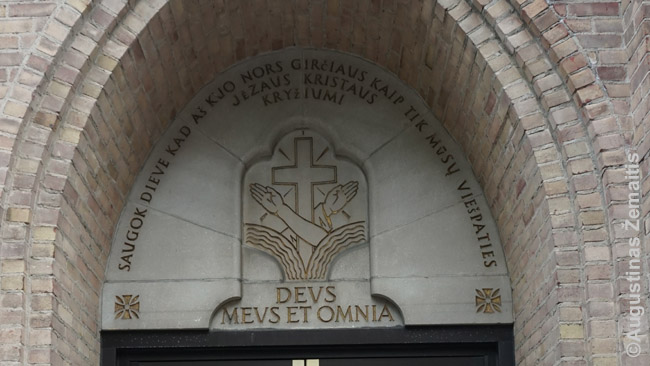

Binghamton Lithuanian church entrance with the Lithuanian text ‚Guard me, oh God, from bragging in anything but in cross of our Lord Jesus Christ‘.
In addition to the "New Church", there is also the Old Lithuanian church on the other side of the street (built in 1916), which later served as a parish hall. Its cornerstone still boasts a Lithuanian inscription reminding of its church origins.
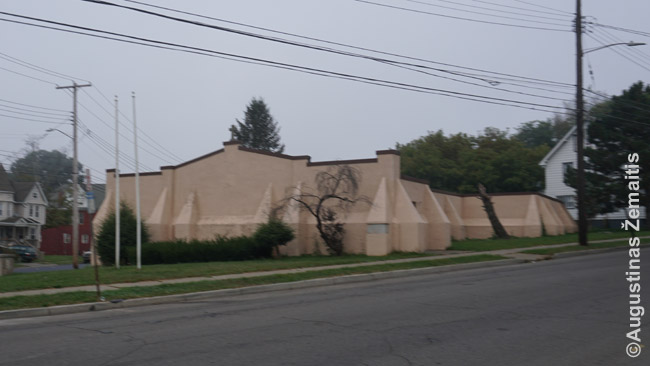

The old Lithuanian ‚basement church‘ in Bingamton.
The map
All the Lithuanian locations, described in this article, are marked on this interactive map, made by the "Destination - America" expedition (click the link):
Interactive map of New York Lithuanian sites
Interactive map of Mohawk Valley Lithuanian sites
Map of Lithuanian heritage in Mid-Atlantic
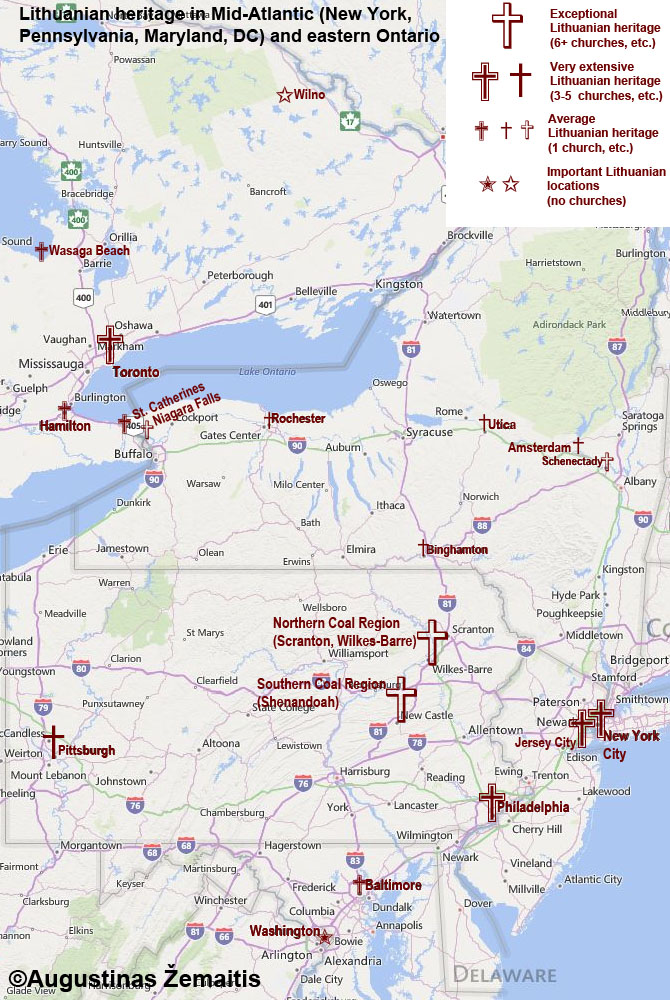

Map of the Lithuanian heritage in Mid-Atlantic (New York, New Jersey, Pennsylvania, Maryland, DC) and western Ontario.
More info on Lithuanian heritage in Maryland, New Jersey, New York, Pennsylvania, Washington, DC, Ontario.




